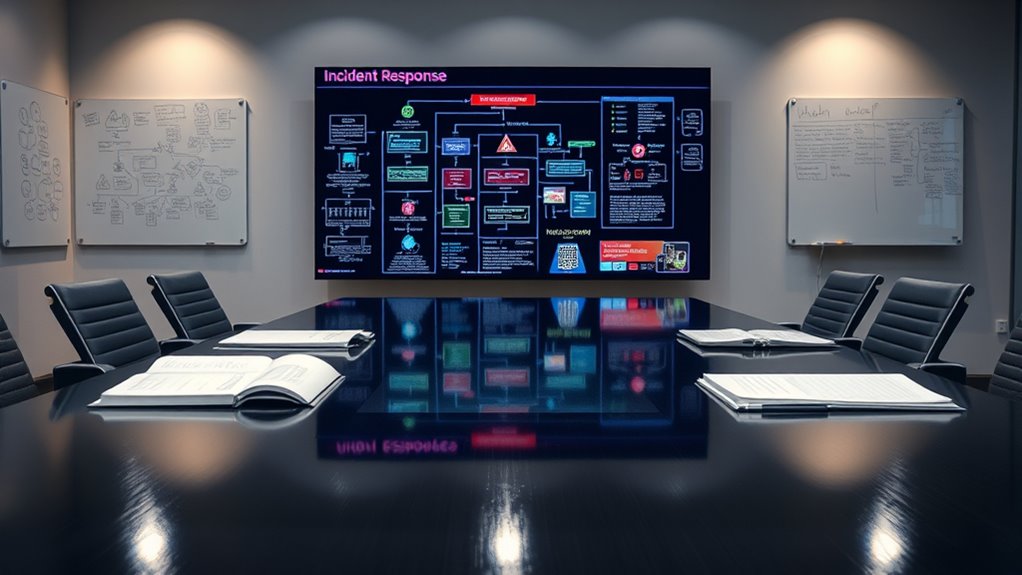To build an effective incident response playbook, start by defining its scope, including incident types like cyberattacks and data breaches, and set clear objectives such as minimizing downtime and protecting data. Identify key stakeholders and establish communication protocols. Map out response procedures, document tools and contacts, and regularly test through drills. Continuously improve your plan based on lessons learned. If you keep going, you’ll learn how to create a all-encompassing, actionable playbook tailored to your organization.
Key Takeaways
- Define incident types, scope, objectives, and critical assets to tailor the playbook effectively.
- Identify stakeholder roles, communication protocols, and escalation procedures for clear coordination.
- Develop specific, categorized response workflows and incorporate continuous improvement through regular drills.
- Maintain updated inventories of tools, resources, and contact information for quick access during incidents.
- Conduct scenario-based simulations and gather feedback to refine procedures and ensure ongoing preparedness.
Assessing the Scope and Objectives of Your Playbook
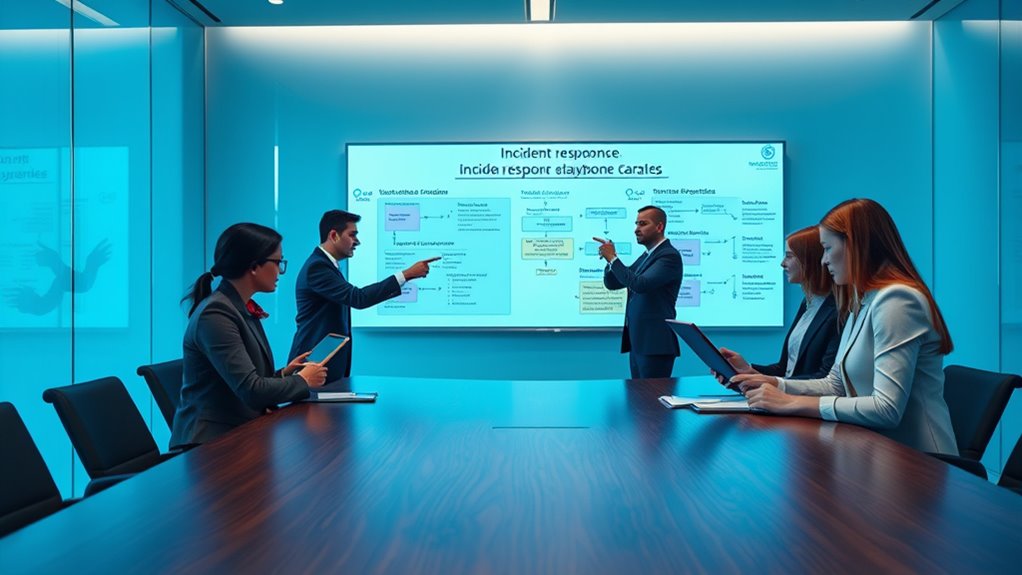
Before you begin drafting your incident response playbook, it’s essential to clearly define its scope and objectives. Your playbook scope determines what types of incidents it covers, such as cyberattacks, data breaches, or insider threats. Objectives clarification helps you set clear goals, like minimizing downtime, protecting sensitive data, or ensuring regulatory compliance. By establishing these elements upfront, you ensure your playbook remains focused and effective during a crisis. Knowing the scope prevents scope creep, while clear objectives guide decision-making and prioritization. Take time to evaluate your organization’s most critical assets and risks, then tailor your playbook accordingly. This foundation guarantees your incident response efforts are targeted, organized, and aligned with your overall security strategy. Incorporating security zone info can further help delineate response areas and responsibilities within your plan.
Identifying Key Stakeholders and Roles
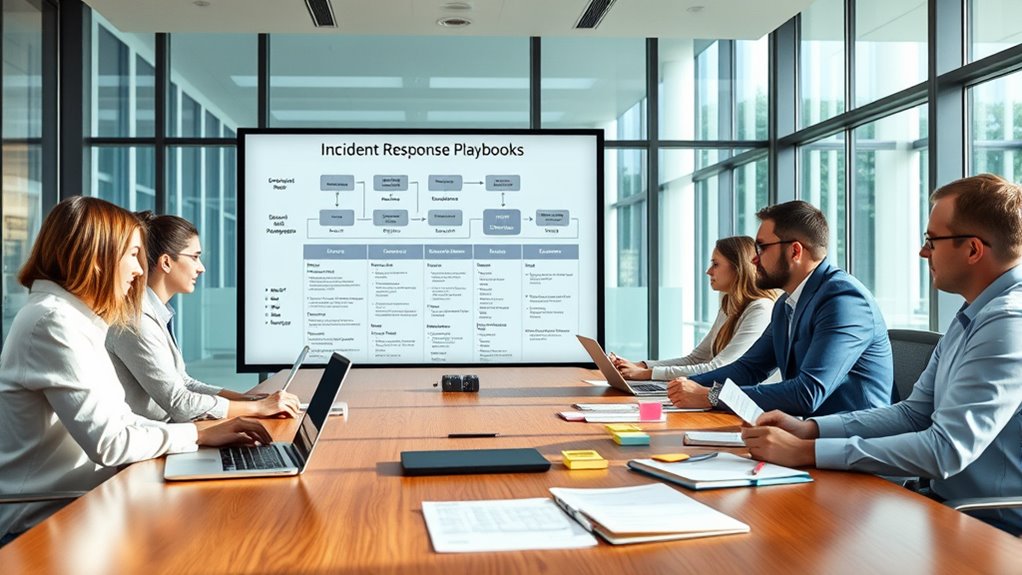
Identifying key stakeholders and roles is a critical step in developing an effective incident response playbook. Clear stakeholder engagement ensures everyone understands their responsibilities, which enhances role clarity during crises. To facilitate this, define who’s involved and their specific duties. Consider the following roles:
| Stakeholder | Role | Responsibility |
|---|---|---|
| IT Security Team | Incident detection and containment | Lead response efforts |
| Management | Decision-making and communication | Approve actions, allocate resources |
| Communications Team | Internal and external messaging | Manage public relations |
| HR | Employee support and compliance | Handle internal personnel issues |
| Legal | Regulatory compliance and documentation | Ensure legal considerations are met |
This table helps streamline stakeholder engagement and role clarity, making your response coordinated and effective. Additionally, understanding the role of contrast ratio in visual clarity can be important when designing physical environments for incident response teams.
Mapping Out Incident Types and Response Procedures
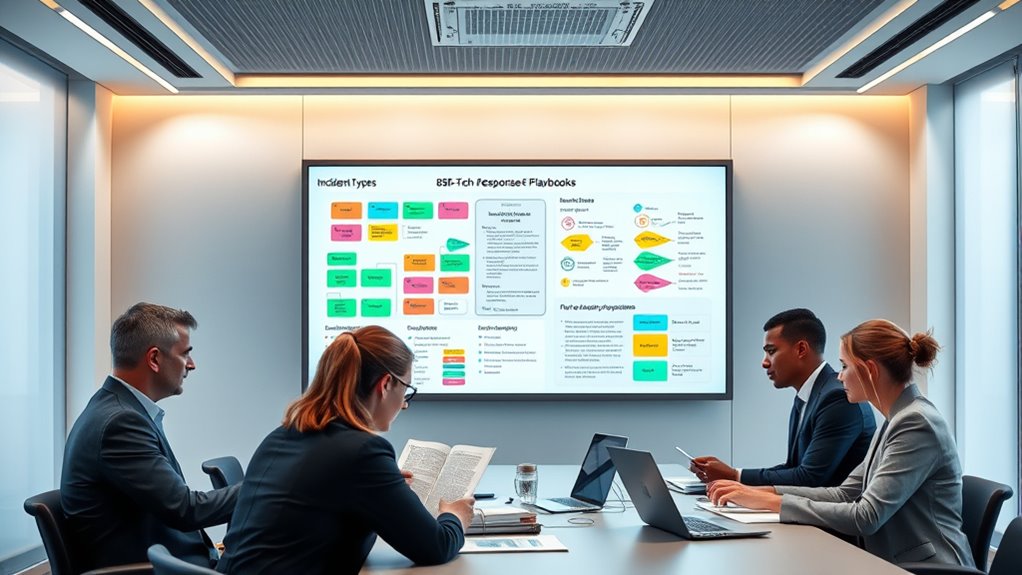
Mapping out incident types and response procedures is essential to guarantee your team reacts swiftly and effectively when a crisis occurs. Proper incident categorization helps you identify the severity and nature of each incident, enabling tailored response workflows. To build a clear framework, consider these steps:
- Define common incident categories like data breaches, system outages, or insider threats.
- Establish criteria for each incident type, including impact and urgency.
- Develop specific response workflows aligned with each category, detailing actions and responsible teams.
- Regularly review and update these procedures based on lessons learned and evolving threats.
- Incorporate understanding of relationship dynamics to improve team communication and cohesion during incident management.
This approach ensures your team knows exactly how to respond to each incident type, minimizing damage and recovery time. Clear mapping guarantees your response process is streamlined and enhances overall incident management.
Incorporating Communication and Escalation Protocols
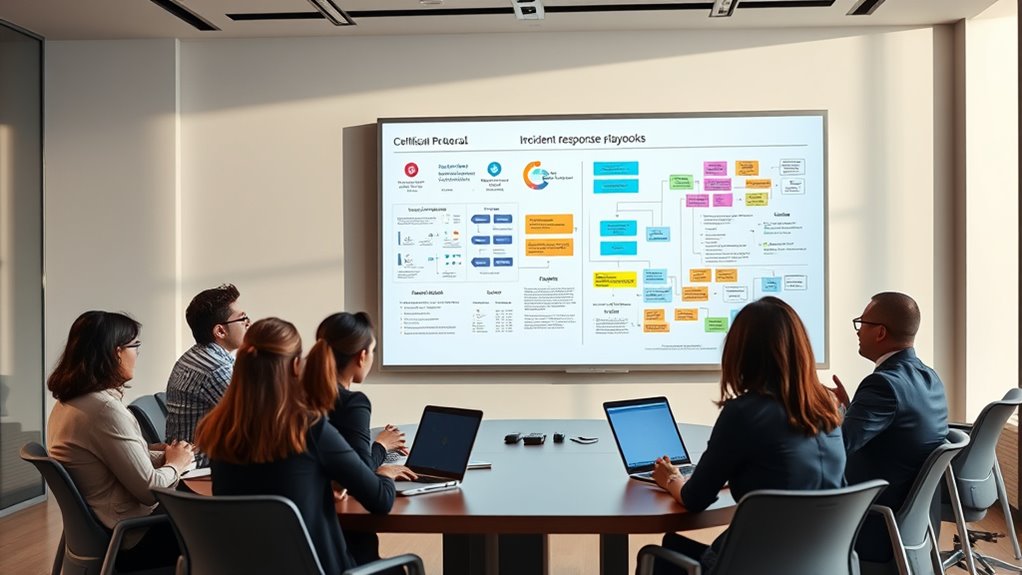
You need to establish clear communication channels so everyone knows how to share and receive critical information quickly. Define escalation criteria to make certain issues are prioritized and handled appropriately. Additionally, outline stakeholder notification procedures to keep all relevant parties informed throughout the response process. Incorporating cybersecurity vulnerabilities awareness into your protocols can further enhance the effectiveness of your incident response plan.
Clear Communication Channels
Clear communication channels are essential for effective incident response, guaranteeing that information flows swiftly and accurately among all team members. When communication barriers arise, they can hinder message clarity, delaying critical actions. To prevent this, establish clear pathways for information sharing, such as designated channels and protocols. Additionally, understanding the importance of family background can help teams better coordinate during incidents involving personal or sensitive information, ensuring respectful and appropriate communication. You should also:
- Define specific contact points for different incident types.
- Use standardized terminology to avoid misunderstandings.
- Regularly test communication tools to ensure reliability.
- Train team members on communication protocols and escalation procedures.
Escalation Criteria Definition
Establishing well-defined escalation criteria is essential for guaranteeing that incidents are addressed promptly and appropriately. You should set clear threshold criteria that determine when an incident moves from one escalation level to the next. These criteria help you identify the severity and impact of an incident, guiding your response efforts. Define escalation levels based on specific indicators, such as system downtime, data sensitivity, or business disruption, so your team knows exactly when to escalate. By establishing precise escalation criteria, you create a structured process that minimizes confusion and delays. This clarity ensures that the right stakeholders are engaged at the right time, maintaining a swift and effective response while avoiding unnecessary escalations for minor issues. Additionally, understanding business hours and store timings can assist in coordinating timely responses, especially when incidents occur outside of typical operating hours.
Stakeholder Notification Procedures
How can you guarantee that the right people are informed promptly during an incident? Clear stakeholder notification procedures are essential. First, establish a communication hierarchy: who reports, who is notified, and who escalates. Second, define media management protocols to handle public communication, ensuring consistent messaging. Third, incorporate legal considerations by involving your legal team early to address compliance and potential liabilities. Fourth, set escalation protocols that specify when and how to inform executive leadership or external agencies. Use automated alerts where possible to reduce delays. Additionally, understanding the legal process of divorce can inform how organizations handle sensitive information during crises. This structured approach ensures everyone receives timely updates, reduces confusion, and maintains trust. Effective stakeholder notification safeguards your organization’s reputation and helps manage incident response efficiently.
Documenting Tools, Resources, and Contact Information

To respond effectively, you need to keep an up-to-date inventory of your tools and resources. Establish clear protocols so team members can access these assets quickly during an incident. Make sure emergency contact lists are accurate and readily available to streamline communication when it matters most. Incorporating company values into your response procedures can help ensure consistent decision-making under pressure.
Tool Inventory Management
Creating a thorough tool inventory is essential for an effective incident response plan. It ensures quick access to critical resources and reduces response time. To do this, you should:
- List all software tools, noting their capabilities and integration points for seamless software integration.
- Document hardware, verifying hardware compatibility with existing systems to prevent delays.
- Record contact information for vendors and support teams for rapid assistance.
- Keep a detailed inventory of resources, including licenses, serial numbers, and access credentials.
- Incorporate Ford Tuning techniques and best practices to optimize tools and resources for specific operational needs.
This organized approach helps you quickly identify tools needed during an incident and avoid compatibility issues. Regular updates ensure your inventory remains current, supporting a swift, coordinated response in any emergency.
Resource Accessibility Protocols
Establishing clear resource accessibility protocols makes certain that all tools, resources, and contact information are readily available when needed. You should identify potential accessibility barriers that could hinder quick access, such as outdated links or restricted permissions. Prioritize resources based on their criticality during incidents to ensure essential tools are always accessible first. Document where resources are stored, including digital repositories and physical locations, so responders can locate them swiftly. Regularly review and update access permissions, eliminating unnecessary restrictions that could delay response efforts. By streamlining these protocols, you reduce delays caused by resource unavailability and ensure your team can act promptly. Clear documentation and resource prioritization help prevent confusion and ensure everyone knows how to access the necessary tools during an incident.
Emergency Contact Lists
Having a complete emergency contact list is essential for quick response during incidents. It ensures you can reach the right people without delay. Effective contact list management streamlines your emergency response planning by keeping critical information organized. To build an effective list, consider including:
- Key internal team members and their direct contact details
- External emergency services like fire, police, and medical responders
- Critical vendors or partners involved in your operations
- Management and executive contacts for decision-making
- Incorporate up-to-date information regarding the latest contact details to prevent communication failures during crises.
Regularly update the list to reflect personnel changes and contact info updates. Store it securely yet accessibly, and test it periodically. A well-maintained emergency contact list minimizes confusion and accelerates action during crises.
Testing and Drilling Your Playbook Regularly
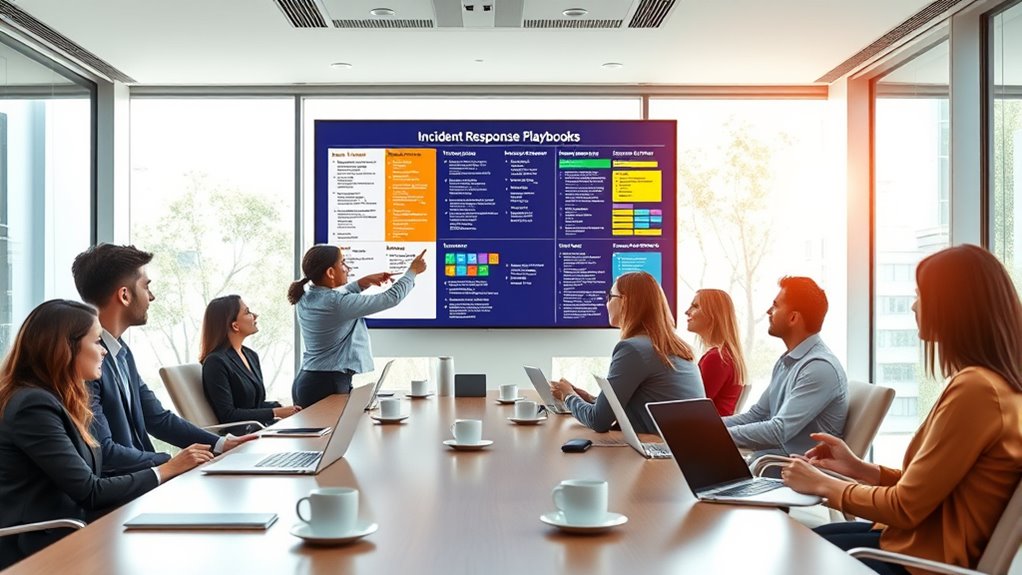
To guarantee your incident response playbook remains effective, you need to test and drill it regularly. Conduct scenario simulations that mimic real-world incidents, challenging your team to respond as they would during an actual event. These simulations reveal gaps in your procedures and help identify areas for improvement. After each drill, gather feedback from participants to understand what worked well and what didn’t. Feedback collection is essential for refining your playbook and ensuring everyone is familiar with their roles. Regular testing keeps your team prepared, reduces response time, and builds confidence in handling incidents. Make testing a routine part of your security culture, so your playbook stays relevant and effective when it’s needed most.
Updating and Refining Based on Lessons Learned

Regular testing and drills help uncover weaknesses in your incident response plan, but keeping it effective requires more than just practice. After each incident or simulation, conduct a thorough incident review to identify what worked and what didn’t. Use feedback integration to incorporate lessons learned into your playbook, ensuring continuous improvement. To refine your plan effectively, consider these steps:
- Gather feedback from team members and stakeholders.
- Analyze incident review data for recurring issues.
- Update procedures to address gaps and ambiguities.
- Re-test revised sections through targeted drills.
Frequently Asked Questions
How Do I Prioritize Incidents Based on Severity?
You start by conducting a severity assessment to understand each incident’s potential impact on your systems and business. Use prioritization strategies like categorizing incidents as critical, high, medium, or low based on factors like data sensitivity, system downtime, and threat level. This helps you focus on the most urgent issues first, ensuring that resources are allocated efficiently and response efforts are effective in mitigating damage promptly.
What Training Is Necessary for Effective Incident Response?
You need training that emphasizes threat detection and team coordination to respond effectively to incidents. Focus on understanding how to identify and assess threats quickly, and practice clear communication within your team. Regular drills and scenario-based exercises will improve your response skills. Guarantee everyone knows their roles and responsibilities, fostering seamless collaboration. This training builds confidence, reduces response times, and helps your team tackle incidents efficiently and effectively.
How Can Automation Improve Incident Management Workflows?
Did you know that automated detection can reduce incident response times by up to 70%? Automation streamlines workflows by enabling quick detection and response, so you don’t waste time on manual tasks. With response orchestration, you coordinate actions across tools seamlessly, ensuring swift containment and remediation. This not only minimizes damage but also frees your team to focus on more strategic efforts. Automation truly transforms incident management into a more efficient, effective process.
What Legal Considerations Should Be Included in Playbooks?
When addressing legal considerations, you should guarantee your playbooks include guidance on legal compliance and data privacy. You need to clearly define procedures for handling sensitive information to avoid violations and legal risks. Incorporate steps for reporting incidents to authorities if required and ensure your team understands privacy regulations. By doing so, you minimize legal liabilities and protect your organization’s reputation during incident response efforts.
How Do I Ensure Playbooks Stay Compliant With Regulations?
To guarantee your playbooks stay compliant with regulations, you should regularly monitor regulatory updates and integrate changes promptly. Conduct compliance audits periodically to identify gaps and verify adherence. Keep detailed documentation of updates and audit results, and train your team on new requirements. This proactive approach helps you adapt quickly, maintain compliance, and avoid penalties, ensuring your incident response processes align with evolving legal standards effectively.
Conclusion
By building a solid incident response playbook, you’re better prepared to handle crises swiftly—think of it as your secret weapon in a world where cybersecurity threats evolve faster than a smartphone update. Regular testing and updates guarantee your plan stays sharp, like a well-honed Excalibur. So, don’t wait for a catastrophe to strike; start crafting your playbook today, or risk being caught flat-footed when the storm hits.
